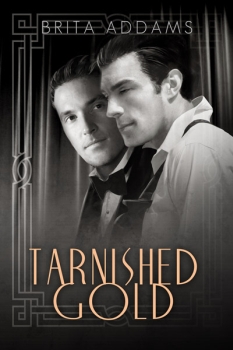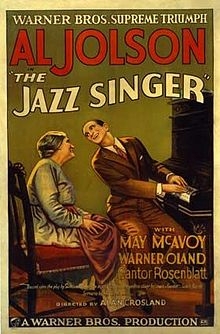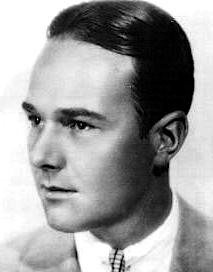|

Tarnished Gold by Brita Addams
ISBN-13: 978-1-62380-423-7
Pages: 350
Cover Artist: Anne Cain
A Cajun lad follows his dream to Hollywood, and stardom places him in the ranks alongside celebrities such as Navarro, Valentino and Barrymore … “Who?” you ask. You’ll need to be an aficionado of Hollywood’s Golden Age to know these names -- they were America’s idols long before movies learned to talk.
Way back in the 1970s, I became fascinated not only by movies but by the filmmaking process. Hollywood history became a fabulous new realm filled with names like Errol Flynn, James Cagney, Spencer Tracy, Gary Cooper, Clark Gable, Robert Taylor, Douglas Fairbanks, Charles Laughton. Today’s general audience views titles pre-1990 as ‘moldy oldies,’ and the usual viewer can’t get into anything that was made before s/he was born. It’s tragic. A world of film, adventure, fascination is closed to them. Vintage movies are pieces of history in and of themselves. Fictional characters like Indiana Jones lived in the era when movies like Captains Courageous, Angels With Dirty Faces, The Hunchback of Notre Dame, King Kong, Stagecoach, The Adventures of Robin Hood, were brand new and shiny…
So Tarnished Gold by Brita Addams, comes as a great pleasure for someone like myself. The book is impeccably researched, with just one or two places where artistic or creative license was used for effect. I enjoyed the Hollywood history a lot. Handsome young Cajun wannabe Jack Abadie and his lover, Wyatt Maitland, are dead lucky: they reached manhood, and celebrity, in a rare lull in America’s homophobia. The 1920s saw an acceptance of gay relationships and behavior that wouldn’t be seen again till the swingin’ sixties. (Around 1933, the pendulum swung back; America became conservative once more, probably with the awareness of an approaching storm, the general belief that a war was coming that would make the ‘Great’ one look tame).
Jack Abadie left Louisiana, landed in Hollywood and was ‘discovered’ at a time when he could be as ‘out’ as William ‘Billy’ Haines (1900 – 1973), openly acknowledge the man who was, by any other name, his spouse, and fly in the face of the studio’s order to get married, or get lost…
Much of the plot of Tarnished Gold concerns a hypothetical studio, Starlight Pictures. Starlight forms a frame on which real Hollywood history is hung, just as in Singin’ in the Rain we see the mayhem that overtook the industry when The Jazz Singer appeared as the first talkie, framed by the fictional studio Monumental Pictures.
The modern reader might need some context to bring this era -- the era in which Jack Abadie becomes a star -- into perspective. It's not as easy to get hold of as the Regency, Edwardian or Georgian eras of historical fiction; not as effortlessly iconic as Westerns and World War II stories. The 1920s is an elusive era. A recent wealth of adventure movies has popularized the 1930s, but the 20s ... well, they weren't called Roaring for nothing! So try this:
Singin’ in the Rain is a fantastic film, made in 1952, color, sound and all -- Hollywood making a movie about itself. It plays the changeover from silents to talkies for pure hilarity; and it doesn’t hurt that Gene Kelly and Donald O’Connor were captured, young and gorgeous! Boy, could they dance. More? Watch Iron Man himself, Robert Downey Jr. in Chaplin, 1992, for a glimpse of the way the moral climate of Hollywood c. 1930 was changing, and how it affected real people who didn’t fit the squeaky-clean mold demanded by the Hayes Code (more on this below. Chaplin’s ‘problem’ was, he liked his women very young indeed -- juuust about legal, if you squint). For another peek at how movies were made in this era, on the cusp of changing to talkies, see the original 1933 King Kong -- another instance of Hollywood making movies about itself -- moreover, in Kong, the original, everything you see was contemporary, state of the art, rather than a modern company making a CGI historical romp … not to say a word against Peter Jackson’s film, which I also loved. The first talkie was, as mentioned above, The Jazz Singer. You can still access it, but since it was made in 1927, little about the production quality or story will allure modern viewers, so I’ve a potentially better one for you: the star of The Jazz Singer was the inimitable Al Jolson, and you can watch the dramatization of the making of the first talkie in The Jolson Story, made in 1946 (color!) with lovely Larry Parks in the title role. If you’re still aboard, see James Cagney in The Public Enemy (1931 -- the recent Johnny Depp movie of the same title is unrelated), which rounds off this era: the transition to talkies was complete. pure hilarity; and it doesn’t hurt that Gene Kelly and Donald O’Connor were captured, young and gorgeous! Boy, could they dance. More? Watch Iron Man himself, Robert Downey Jr. in Chaplin, 1992, for a glimpse of the way the moral climate of Hollywood c. 1930 was changing, and how it affected real people who didn’t fit the squeaky-clean mold demanded by the Hayes Code (more on this below. Chaplin’s ‘problem’ was, he liked his women very young indeed -- juuust about legal, if you squint). For another peek at how movies were made in this era, on the cusp of changing to talkies, see the original 1933 King Kong -- another instance of Hollywood making movies about itself -- moreover, in Kong, the original, everything you see was contemporary, state of the art, rather than a modern company making a CGI historical romp … not to say a word against Peter Jackson’s film, which I also loved. The first talkie was, as mentioned above, The Jazz Singer. You can still access it, but since it was made in 1927, little about the production quality or story will allure modern viewers, so I’ve a potentially better one for you: the star of The Jazz Singer was the inimitable Al Jolson, and you can watch the dramatization of the making of the first talkie in The Jolson Story, made in 1946 (color!) with lovely Larry Parks in the title role. If you’re still aboard, see James Cagney in The Public Enemy (1931 -- the recent Johnny Depp movie of the same title is unrelated), which rounds off this era: the transition to talkies was complete.
Okay, now you have context. In this amazing world, Jack Abadie leaves Louisiana, headed for Hollywood with the ambition of being a star, only to end up waiting tables, until he’s ‘discovered’ by an out gay director who feed him into the Hollywood system. Nobody in those days went to acting school. You signed on as an extra, learned the ropes by watching, imitating; were promoted to a bit-player and, if you had the talent, made it all the way up to star. If you had the looks, you went a step further -- matinee idol. Jack had the talent, and the looks; and was lucky enough to make his name, and the base of his fortune, in a brief period in America’s somewhat hidebound history, where you could be gay, and even out, and still get work.
But even Jack and his lifetime partner Wyatt would run afoul of the Hayes Code -- film censorship which pertained not merely to on-film events, but also to the lives and loves of performers and directors. One wants to say, “Only in America,” but I’m sure other countries must have indulged in such heavy-handed and official invasions of privacy -- homosexuality was a prison offense in the UK until distressingly recently, for instance. Certainly, gay behavior in public was still illegal in the US, and the end of the ’20s saw the end of the sunny period of tolerance for the promiscuity and homosexuality with which Hollywood had been so busy. Bill Haines himself (right), on whom Jack Abadie is, in part, based, was arrested in ’33, for picking up a sailor. Public sentiment had swung far enough by ’36 that Haines and lifelong partner Jimmy Shields were physically assaulted as a couple, when a neighbor intimated that one or both had made improper advances to a minor. During the ’20s, inspired by the Berlin film industry, Hollywood issued some increasingly risqué, controversial and experimental movies; the decade’s general decadence led to a string of ‘scandals,’ from rape and drug use and trafficking to murder. Studio spin-doctoring turned into a media circus … final result: the Hayes Code, which wrangled the end of careers for performers like Bill Haines, who was contractually ‘owned’ by studios who were, in turn, ‘owned’ by the banks who financed pictures… and loves of performers and directors. One wants to say, “Only in America,” but I’m sure other countries must have indulged in such heavy-handed and official invasions of privacy -- homosexuality was a prison offense in the UK until distressingly recently, for instance. Certainly, gay behavior in public was still illegal in the US, and the end of the ’20s saw the end of the sunny period of tolerance for the promiscuity and homosexuality with which Hollywood had been so busy. Bill Haines himself (right), on whom Jack Abadie is, in part, based, was arrested in ’33, for picking up a sailor. Public sentiment had swung far enough by ’36 that Haines and lifelong partner Jimmy Shields were physically assaulted as a couple, when a neighbor intimated that one or both had made improper advances to a minor. During the ’20s, inspired by the Berlin film industry, Hollywood issued some increasingly risqué, controversial and experimental movies; the decade’s general decadence led to a string of ‘scandals,’ from rape and drug use and trafficking to murder. Studio spin-doctoring turned into a media circus … final result: the Hayes Code, which wrangled the end of careers for performers like Bill Haines, who was contractually ‘owned’ by studios who were, in turn, ‘owned’ by the banks who financed pictures…
This was Jack Abadie’s world, and it’s brought to life with aplomb by Brita Addams, in an immense storyline. The plot of Tarnished Gold is huge -- in fact, it’s so big that to accommodate it, much of the story must be synopsized, told in shorthand (which can, on occasion, seem a little odd, when a long run of plot synopsis is punctuated by a big sex scene detailed almost to the skin-follicle level. This seems to be a device of m/m though, so where I’m noticing a lumpiness in the narrative, a reader who’s immersed in m/m probably wouldn’t notice anything amiss. Horses for courses).
The suicide of a friend and old flame, the loss of his parents, the financial ruin of his bother, all put Jack through the wringer. The events of Tarnished Gold are often traumatic, and it would be so easy to ‘overwrite’ this kind of material, turning drama into meoldrama. The book is commendably underwritten -- the author makes a conscious, and effective, effort to understate the trauma and keep a stranglehold on the narrative line. In one or two places, the grip is even a tiny bit too tight. Late in the book, when Jack and Wyatt are involved in a bad car accident, the underwriting makes a horrific on-road smash positively bland.
The strength of the book is the history -- a time and a place that are brought to life wonderfully. I have only minor quibbles, such as the inclusion of a serious spanking fetish for Wyatt, which seems like an added-on afterthought, something to spice up a book that, throughout the first three-quarters, is devoted to plot, not sex. (The sex piles on, in the book’s home stretch; too much for me, but other readers might have been hanging on, praying for it. Sex wise, I do have a wee problem with Wyatt’s pain-free athleticism in bed right after being busted to splinters in the aforementioned car crash.) The sm aspect to the romance between Jack and Wyatt has a “What, now?” aspect … to me, it seems artificial for the characters, and was superfluous to the plot. I’ve confessed elsewhere, all the sub-dom-sm stuff makes zero sense to me, so I guess -- “Why would you include this in a book like Tarnished Gold?” Answer: “Why not?” If you enjoy industrial grade spanking, read on; if not, like me, hit ‘turn page’ till they’re done making each other sore, and get back to the story! A more substantial misgiving about the plot is that everything, everything, Jack turns his hand to after being discovered, turns to gold. Every picture he makes is a hit; he’s a megastar; every business deal would make Midas jealous; when he and Wyatt buy Regency Pictures after the Crash of ’29, it’s a foregone conclusion they’ll succeed, and when Jack’s last picture is nominated, big time, for the fourth Academy Awards … aha.
Overall, Tarnished Gold is great read. For me, it’s at its best when fact and fiction merge -- when the life of Jack Abadie, as loosely based on the events surrounding Bill Haines, brings America, circa 1930, into sharp focus through the lens of the gay community, and particularly Hollywood's gay community. There are times when the book tickles mainstream, close to the ‘crossover’ novel that’s been called the ‘holy grail of gay fiction.’ Take out the dedicated material that was most likely added to make it qualify as m/m, and Tarnished Gold could be shelved with gay literature or even mainstream historical literature. And that’s high praise.
Recommended for readers who like an impeccably researched historical … for anyone who has a fascination for the tinsel-town of yesteryear, or even a sneaky crush on the likes of Errol Flynn! … and for readers who like a sexy romp with a few liberal doses of buttock-blistering, or else, like me, are willing to the hit the fast forward, back to the delights of a historical where fact and fiction blend into a delicious melange.
|
